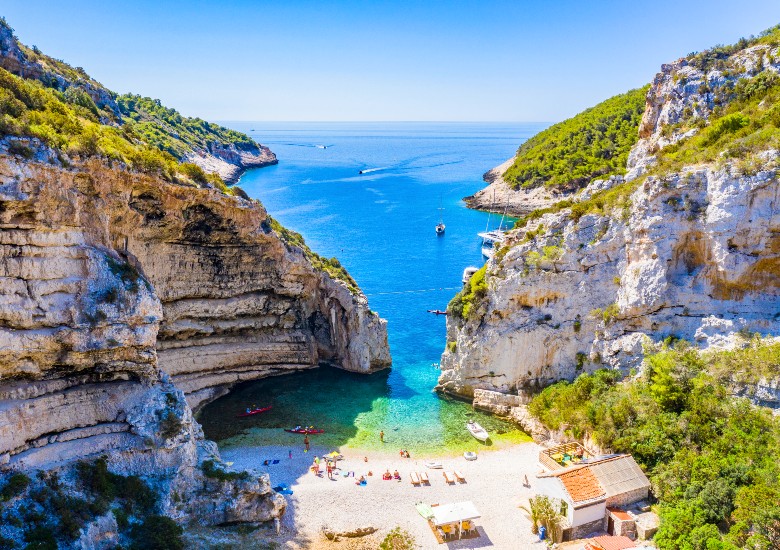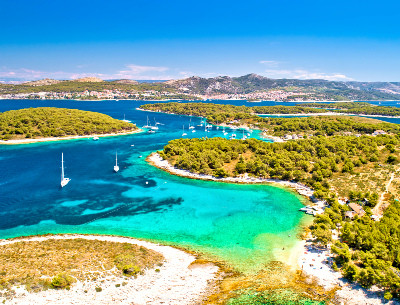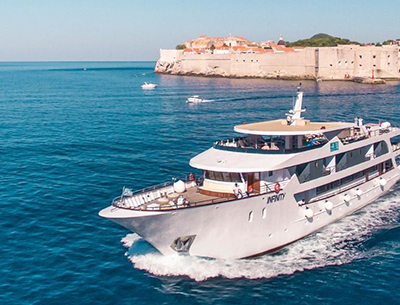Best Islands to Visit in Croatia
With over 1,000 islands and islets scattered in the Adriatic Sea, Croatia has one of the most beautiful coastlines in Europe, home to fascinating heritage cities and extraordinary national parks. No two islands are the same, and with so many to choose from, it can be difficult to know where to go on your vacation. One of the best ways to explore Croatia’s expansive coast is on a small ship cruise, providing the opportunity to visit the more remote islands that are harder to otherwise access. From lively Hvar to tranquil Mljet, here are our top picks for the best islands to visit in Croatia.
Located in the central Dalmatian archipelago, Hvar Island is known for its idyllic beaches, vineyard-covered hills, and fragrant lavender fields that blanket the landscape with purple in June. The island has a rich history, with its Old Town home to a number of impressive landmarks such as St. Stephen’s Cathedral and its encircling thirteenth-century walls. Alternatively, the towns of Stari Grad (one of the oldest in Europe), Jelsa, and Vrbovska provide a quieter, more authentic side to the island.
Hvar is also a top spot for international jet setters, including Hollywood stars, who often arrive in mega-yachts to take advantage of the world-class restaurants and lively nightlife in Hvar town. Aside from its beautiful coastline and historic towns, there are some fantastic family-run Croatian wineries throughout the island that can be visited for wine tasting and touring.
Covered with pine forests, olive groves, and vineyards, Korcula is a small island in the Adriatic Sea, just 20 miles long and a firm favorite amongst travelers to Croatia. The island’s Old Town, the alleged birthplace of intrepid explorer Marco Polo, is surrounded by walls, gates, towers, and bastions, and is often called ‘mini Dubrovnik’ due to its Venetian influences.
Away from the Old Town, Korcula boasts a beautiful coastline with many beaches and idyllic coves that are perfect for sunbathing and swimming, particularly in Lumbarda at the eastern tip of the island. The island is also renowned for its olive oil, wine, and seafood, all of which must be sampled on a visit here.
Remote Vis is the farthest inhabited island off the Dalmatian coast and one of the most unspoiled. Often called the “Mediterranean as it once was,” it was closed off to the public for 40 years while used as a strategic naval base, leaving it spared from much tourism development. With a fascinating history, picturesque beaches, and locally produced wines, Vis is often considered to be one of the best islands to visit in Croatia.
From the harbor at the foot of the Bay of St. George, a seaside promenade leads to Vis Town where travelers can be immersed in the island’s rich past by discovering Greek and Roman ruins, Renaissance palaces, and historic churches. Take in panoramic views of the island with a hike to Mount Hum, and make sure to visit some of the island’s beaches, including one of Croatia’s most beautiful: Stiniva.
The third largest island in the Adriatic, Brac is best known for Zlatni Rat, one of Europe’s most photographed beaches due to its unique and changing shape that juts out a third of a mile into the turquoise water. Yet, there’s a whole lot more here than beaches, with the fishing village of Bol offering many excellent restaurants serving local specialties, including peka dishes made with fresh seafood.
Also on the island is Pucisca, a charming seaside town with a picturesque bay that’s home to the Stonemasonry School and Quarry, where the white limestone used to build Split’s iconic Diocletian’s Palace is from, one of the best UNESCO Sites in Croatia. A range of activities can be enjoyed on the island in addition to swimming, including sea kayaking, windsurfing, mountain biking, and hiking.
With its mild Mediterranean climate, lush vegetation, and crystal-clear waters, Losinj is known for its natural beauty and therapeutic air, attributed to the aromatic herbs that grow abundantly on the island. The island is part of the Cres-Losinj archipelago in the northern Adriatic Sea; its main town, Mali Losinj, is a charming hub with pastel-colored houses, a lively waterfront, and a rich maritime history.
Visitors can explore the Museum of Apoxyomenos, housing a well-preserved ancient Greek statue found in the local waters. The island is also celebrated for its dolphin population, with many opportunities here to embark on dolphin watching excursions. For scenic walking and cycling trails, head to Cikat Forest Park, while the island’s numerous coves and beaches provide idyllic spots for swimming.
Rab, situated in the northern Adriatic Sea, is celebrated for its rich history, stunning landscapes, and vibrant atmosphere. The main town, also named Rab, boasts a well-preserved medieval core with charming cobblestone streets, iconic bell towers, and historic churches, such as the Cathedral of St. Mary. The island’s four bell towers create a distinctive skyline that has earned Rab the nickname “the Happy Island.”
Its beaches are renowned for their beauty and diversity, ranging from sandy shores like Rajska Plaza (Paradise Beach) to more secluded pebble coves. Rab has a tradition of hosting cultural events, including the famous Rab Arbalest Tournament, showcasing medieval archery. The island is also known for its unique Rapska fjera, a historical festival commemorating the town’s medieval charter.
Mljet, situated in the southern part of the Adriatic Sea, is renowned for its lush greenery, pristine landscapes, and unique natural attractions. The island is largely covered by dense Mediterranean forests and features two interconnected saltwater lakes, Veliko and Malo Jezero, located within the boundaries of Mljet National Park.
Visitors can explore the park’s trails, which lead to charming islets, ancient ruins, and the 12th-century Benedictine monastery on St. Mary’s Island in Veliko Jezero. Mljet is often referred to as the “Green Island” due to its abundant vegetation, including pines, olives, and cypresses. Beyond its forests, the island’s coastline is adorned with secluded coves and crystal-clear waters, making it a haven for swimming, snorkeling, and other water activities.
Sipan, the largest of the Elaphiti Islands, is known for its tranquility, historical charm, and lush landscapes, with only a little more than 400 permanent inhabitants living here. Located northwest of Dubrovnik, Sipan boasts olive groves, vineyards, and citrus orchards, creating a green haven against the backdrop of the turquoise waters.
The island is home to two main settlements, Sudurad and Sipanska Luka, both featuring well-preserved medieval architecture, including churches, monasteries, and quaint stone houses. Sipan’s history is reflected in its numerous ruins, such as the remains of a Roman villa and a medieval fortress. Visitors can explore the island’s scenic walking and biking trails, leading to secluded coves and viewpoints.
Inhabited since the Paleolithic era, Cres is the second-largest island in Croatia and part of the Kvarner Gulf archipelago. Characterized by a diverse landscape of rugged cliffs, dense forests, and hidden coves, Cres is a haven for nature enthusiasts and those seeking a tranquil escape. The island is home to the enchanting town of Cres, known for its medieval charm, narrow winding streets, and historic architecture, including the 15th-century Franciscan Monastery.
The ancient town of Osor, situated on a narrow channel connecting Cres and Lošinj islands, adds to the cultural richness of the area with its archaeological sites and Romanesque cathedral. The island is also recognized for its griffon vulture population, and visitors can have the opportunity to witness these majestic birds in the Tramuntana cliffs.
Dugi Otok, translating to “Long Island” in Croatian, is a captivating gem in the Zadar archipelago of the Adriatic Sea. Renowned for its natural beauty, the island offers a diverse range of landscapes, from rugged cliffs and dramatic rock formations to peaceful bays and sandy beaches. One of its notable attractions is Telascica Nature Park, a protected area featuring a stunning bay, sheer cliffs, and a salt lake known as Mir.
The island’s Veli Rat lighthouse stands as a picturesque landmark on its northwest coast, while the charming village of Sali provides a taste of local culture with its traditional architecture and lively events, such as the Sali Cultural Summer. Dugi Otok is also celebrated for its crystal-clear waters, making it an ideal destination for swimming, snorkeling, and boating.
The island of Pag, located in the northern Adriatic Sea, is known for its unique lunar-like landscape, its stark, rocky terrain contrasting beautifully with the surrounding azure water. Here, travelers can taste the flavors of the island’s time-honored traditions of wine and cheesemaking, with Pag cheese being one of the country’s most celebrated culinary exports, its distinctive flavor derived from the aromatic herbs the local sheep graze on.
Pag Town boasts medieval streets overlooked by a 15th-century cathedral, with visitors here able to explore historic sites such as the Church of St. Mary and the Pag Lace Gallery, showcasing the traditional craft of Pag lace-making. The island also boasts stunning beaches, including the famous Zrće beach which is known for its lively nightlife.

































